Diwali celebrations in India are more than just a festival, they are a tapestry of light, sound, and memory. As a kid in the 80s, Diwali was the most favorite time of the year for me, and it still is. The smell of marigolds and incense filled the air, streets glowed with flickering diyas, and the sound of laughter and sparklers echoed through every lane.
While the heart of Diwali, the lights, sweets, and joy of being together, remains the same, the ways we celebrate have changed. Technology, modern lifestyles, and new trends have left their mark on this timeless festival.
This post isn’t about whether Diwali was better back then or now. It’s a reflection on how times have changed and how those changes have shaped the way we celebrate. For those in their 40s, it’s a nostalgic time capsule; for younger readers, it’s a glimpse into the Diwalis of generations before you.
1. Cleaning & Shopping for Diwali
As a kid, one of the best things about Diwali celebrations in India was that, unlike other festivities, it wasn’t just about “that one day.” Diwali preparations have always been as much a part of the festival as the lights and sweets themselves.
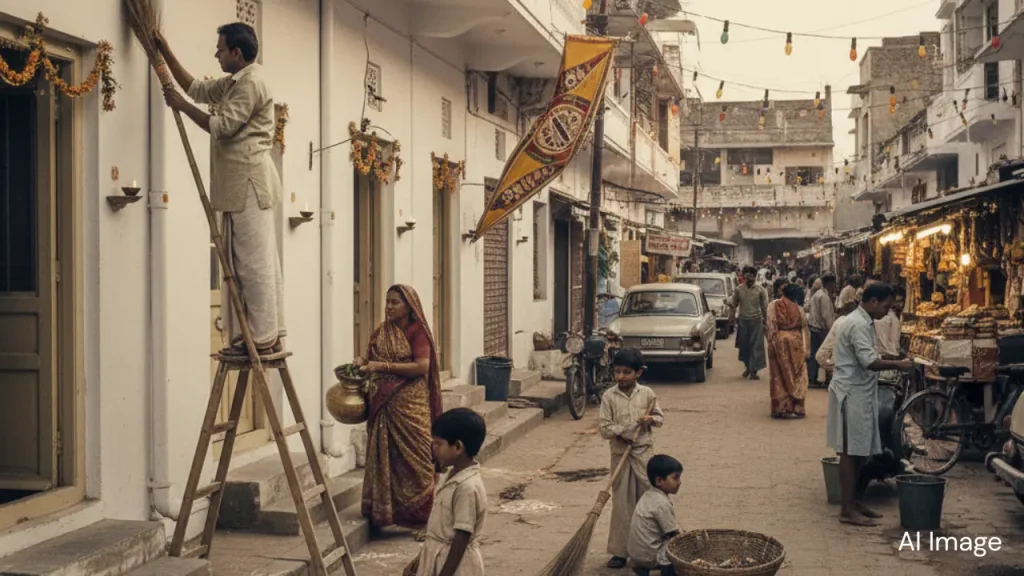
Professional Cleaning vs Family & Neighbourhood Prep
In the past, homes would start to sparkle a week in advance, with every corner scrubbed, floors polished, and windows shining. Families worked together, and sometimes even neighbours joined in, sweeping building corridors, arranging flower garlands, and decorating common spaces.
Children ran errands for diya oil, marigolds, and laddoos, turning chores into an adventure. The act of preparing, the smells of cleaning powders, the laughter, and the shared anticipation, was a celebration in itself.
Today, the ritual has shifted. With the concept of nuclear family on the rise, many households hire professional cleaning services, and the emphasis is on convenience. Homes may look pristine, but the communal spirit of neighbourhood collaboration has faded.
Shopping Online & Malls Vs Local Bazaars
Shopping has undergone an even bigger transformation. Today, Diwali shopping is all about scrolling through the endless list of items on shopping sites and apps. Various e-commerce vendors like Amazon, Flipkart, Myntra, BlinkIt and others come out with various discount days for which they rope in some of the biggest Hindi movie stars and celebs (as if these stars are desperately buying these ₹999 items).
Those interested in offline shopping, head out to various malls where they can grab some stunning ethnic wear, designer clothes and much more. Overall, luxury, convenience and comfort are integral to the Diwali shopping experience.
Then, the local bazaars were alive with festive vibes, vendors calling out, the scent of sweets mingling with fresh rangoli powders, and the thrill of bargaining over colourful saris, diyas, and firecrackers. For me, each trip to the local markets and stores in Mumbai was a sensory adventure, an integral part of the festival.
While shopping apps and malls offer ease and efficiency, the overall experience of heading to local bazaars, the sights, smells, sounds, bargaining conversations, bumping into relatives and acquaintances and having spontaneous interactions have largely disappeared.
Even in preparation, then and now, the heart of Diwali, care, anticipation, and togetherness, remains, but the way it manifests has evolved with the times.
2. Lights & Decorations for Diwali
Lighting up homes and streets has always been the heart of Diwali. So a lot of thought would go into how people would want to light up their homes, balconies and corridors. Being born and brought up in a chawl in Mumbai, this was the only time of the year when every corner of my building was filled with lights.
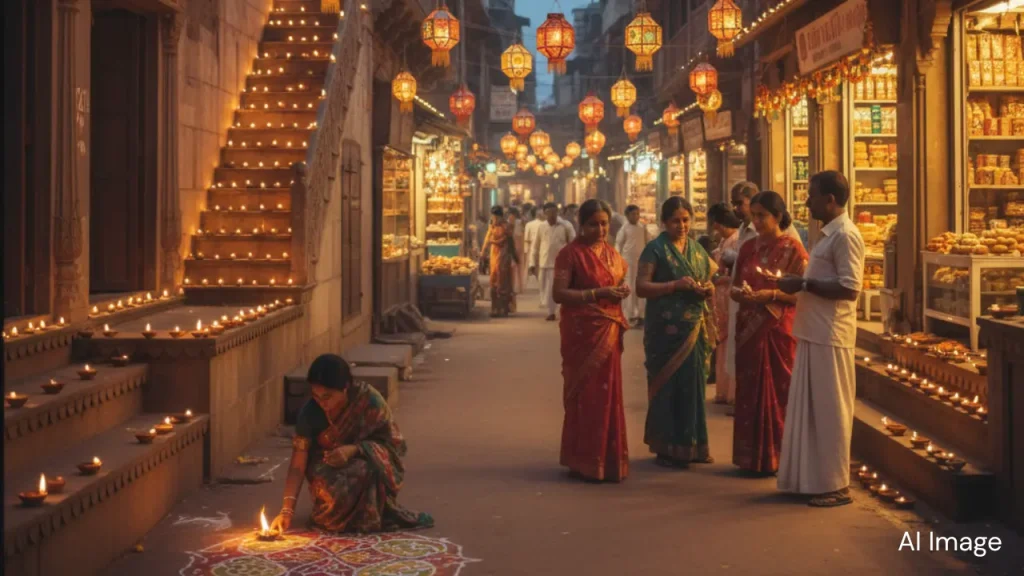
Tea Light Candles vs Earthen Diyas
Today, if you are shopping in DMart or IKEA, you would find huge packets of tealight candles which people prefer to use. Not that I’m against it, but it is just another example of how the concept of convenience has evolved.
For those, who want to participate and be a part of the festival without the mess of oils and earthen diyas, these candles are a great alternative. At the end of the day, it is the intent that matters.
However, back in my childhood days, my mother would painstakingly clean and arrange rows of earthen diyas, each filled with oil and carefully placed to illuminate windows and balcony areas.
The soft flickering glow of these tiny lamps created a magical warmth that wasn’t just visual, it felt alive. With a simpler lifestyle and more time at hand, people would go an extra mile to create elaborate rangoli designs and place earthen diyas that truly made Diwali unforgettable.
LED Lights vs Classic Bulbs
There is no doubt that LED lights have changed the way we illuminate spaces and today Diwali might be brighter thanks to these tiny light emitting diodes. From fancy shopping mall spaces to local street markets, LED lights and fairy strings have become a common sight. These lights are undeniably bright, precise, uniform and glow in every imaginable colour making Diwali a better experience.
Back in those days, regular tungsten bulbs were a norm. While they had their drawbacks of getting hot and pushing your utility bill cost, they still had their unique charm which is often missing these days.
Decorative trends have also become more commercialized, with pre-made plastic garlands, plastic lanterns, and themed lights dominating the market. The good part is that while the medium may have changed, the joy of illuminating spaces, both physical and emotional, continues to connect families and communities.
3. Games, Entertainment & Greetings
Back in those days, Diwali was the best time of the year for us kids as the exams are over and we’re enjoying the holidays. This means no more preparing a schedule for the next day, no more waiting for school buses, and certainly no homeworks. This means we had plenty of time to loiter around at our friend’s houses in the building or community.
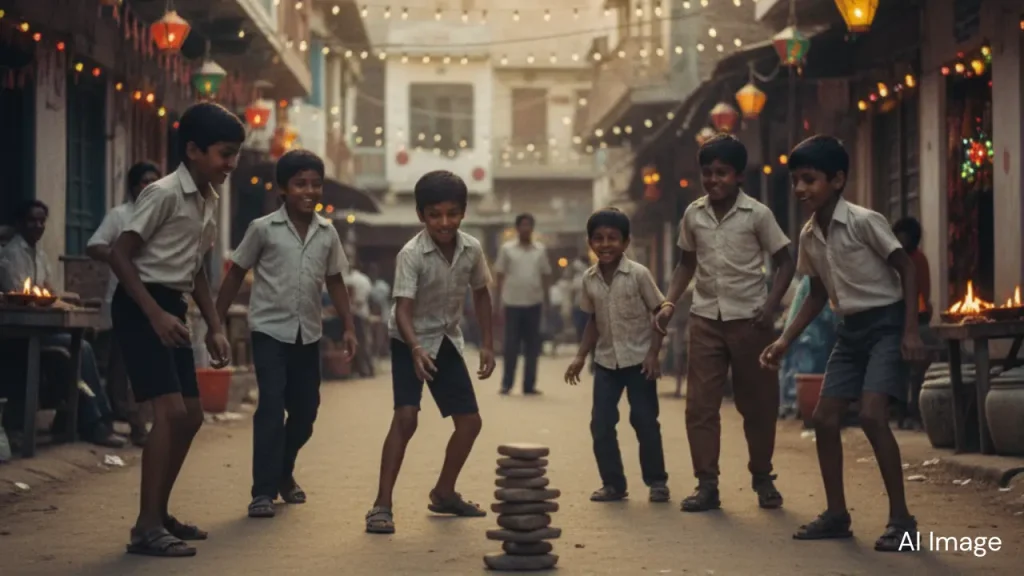
Online Games vs Street Games
Today, Diwali celebrations often look different. Children and adults are more likely to be distracted by smartphones, video games, or streaming content. Firecrackers are used less, partly due to awareness of pollution and partly because the thrill of outdoor play has been replaced by digital alternatives.
Even when kids are with their friends, they are each busier in their smartphones interacting in a virtual world than the real one. Yes, there are still kids that run around bursting crackers, drawing rangolis and screaming their lungs out, but they are far and few.
Diwali in the 80s was nothing short of a God-given opportunity to make the most of the time with friends. We would play langdi, hopscotch, kho-kho, lagori also known as Pitthu (Seven Stones), cricket, and badminton for endless hours until our parents would order us back home.
When not playing around, we would gather around the building staircase and play Antakshari, Name-Place-Animal-Thing, Carromboard, Cards and various boardgames like Snakes and Ladders and Ludo.
Personalised Streaming Content vs Community Experience
We live in a world where personalised streaming content and video experiences have become a routine. People today love to watch their favorite movies, TV series and various types of content on their mobile devices.
With the introduction of streaming giants like Netflix, Amazon Prime and others, parents and kids no longer have to submit themselves to watching the same programmes. Various households have multiple TV sets allowing family members to watch what they like.
Back then, the lack of multiple TV channels would often lead to a collective watching experience. With many families unable to afford television sets and VCRs, things were quite different from the way it is today.
However, the joy came from community experiences and the thrill of watching family, friends and neighbours gather around a single television set for a festive movie or special show. Shows like Ramayana, Mahabharata, Hum Log, Buniyaad, Yeh Jo Hai Zindagi, Wagle Ki Duniya, Malgudi Days, Surabhi and Chitrahaar touched mythological and social topics. Hence, entertainment was collective, simple, and woven into the fabric of family life and society at large.
Digital Greetings vs Handmade Cards & Gifts
Diwali celebrations in India seem incomplete without greetings and festive messages that set the mood across the city and country. With smartphones and laptops easily accessible, Diwali greetings today are often passed through WhatsApp forwards, Canva-designed Facebook messages, Instagram Stories and Reels.
Families may sit in the same room, but each person is often absorbed in their own device, their laughter and conversations replaced by scrolling screens.
The absence of mobile devices and internet back in the 80s would mean that one has to look out for festive paper-based greeting cards or create one. Shops like Archies and various local stationery stores would sell cards, craft items and amazing Diwali gifts that you can gift to your loved ones, friends and acquaintances.
While it might seem that the charm of connectivity has lost, I would argue that the essence of Diwali has simply shifted. From physical outdoor games to PubG, from physical greeting cards to WhatsApp forward the way we connect has changed, but the desire to connect remains timeless.
4. Fashion & Trends During Diwali
Apart from buying Diwali lanterns, diyas, and crackers, Diwali celebrations in India are incomplete without buying new clothes. Festive fashion has always been a big part of Diwali, but its inspiration has shifted over the years.
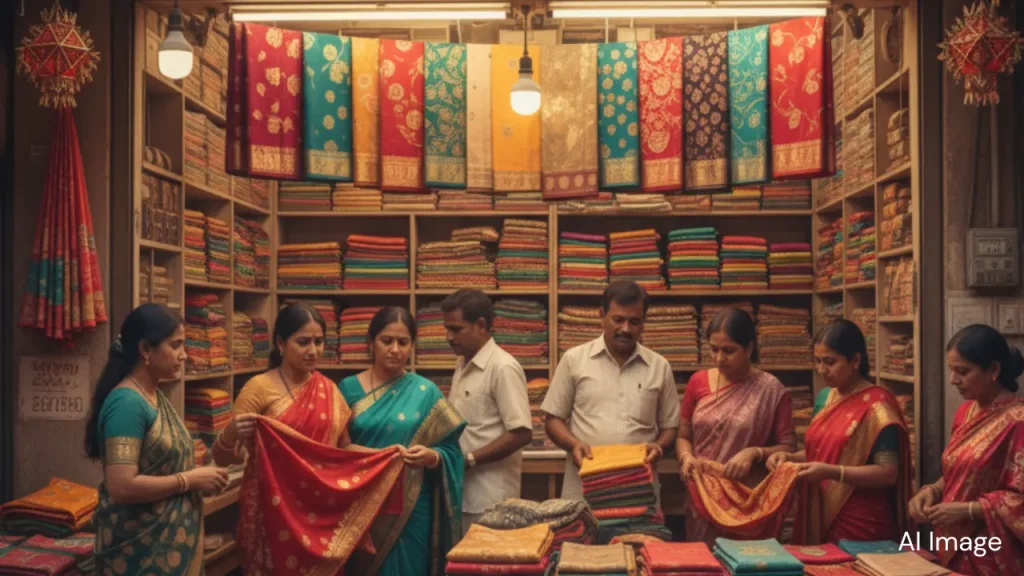
Designer Diwali vs Bollywood-Inspired Styles
Today, Diwali fashion has become far more designer-driven and brand-conscious. Various e-commerce giants like Myntra, AJIO and others come out with seasonal sales and discounts to lure potential buyers. Instagram reels, fashion influencers, and celebrity endorsements shape what people wear, with trends spreading faster than ever
Those who prefer shopping offline often head to shopping malls. Fast fashion stores like H&M and ZARA often curate “festive collections” each year. These collections often have a fusion of Indo-western wear which now replaces the traditional kurta-pajama or saree. Some of the top shopping malls in Mumbai try to recreate Diwali vibes to attract potential buyers.
With the absence of shopping malls, Diwali shopping in India was a different story back in the 80s and 90s. Hindi films had a decent amount of influence on the fashion trends. Back in those days, Aamir Khan’s Captain-embossed cap from Dil Hain Ke Manta Nahin or Madhuri Dixit’s purple saree from Hum Aapke Hain Koun! would quickly filter into local markets.
Tailors worked overtime before Diwali, stitching made-to-measure outfits, while children often wore clothes gifted by relatives. Dressing up was less about standing out and more about feeling festive and connected to cultural icons.
While earlier fashion carried the charm of aspiration and personal touches from local tailors, modern Diwali fashion emphasizes individual expression and global influences. Both eras celebrate dressing up, but where the past borrowed glamour from Bollywood, today’s styles are more about curated choices and being in sync with global trends.
5. Social Connections & Experiences During Diwali
Diwali has always been about people as much as lights. This is the time when people want to connect with their loved ones, distant relatives, friends, acquaintances and ensure that they’ve not missed out on anyone on their list.
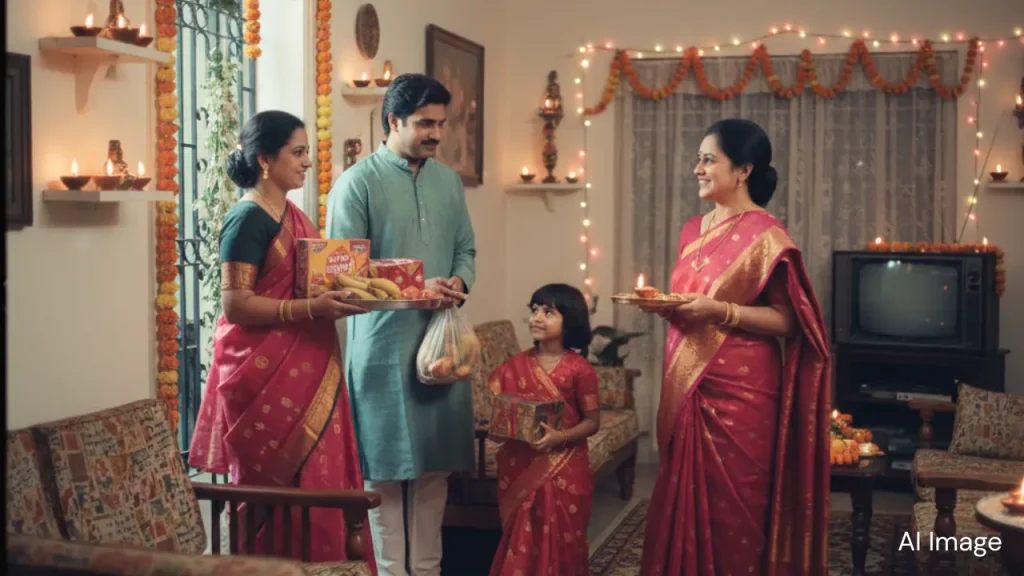
Scrolling WhatsApp Messages vs Visiting Loved Ones
While connections are still very much at the core of Diwali festivities, a lot of these often take place on WhatsApp screens more than in living rooms. Instead of relatives knocking on the door unannounced, festive greetings arrive as early morning WhatsApp messages, Instagram stories, or carefully curated reels.
Back then, homes buzzed with unannounced visits from relatives and neighbours who dropped in to share some homemade sweets and delicacies. Conversations flowed over endless cups of chai, Gold Spot and Mangola, laughter echoed as children darted around, showing off new clothes or sparklers. The lack of formality and the idea of togetherness, warmth and joy of being in each other’s company was dominant.
Presenting the Moment Online Vs Being Present in the Moment
With everyone having a mobile device, Diwali festivities and life in general today revolves around documenting the moments rather than living the moment. For many of us, it is all about capturing everything on their smartphones so that they can make reels, stories and YouTube shorts out of it.
From capturing private dinner moments at a restaurant to recording happy moments with family, everything has to be exhibited online only to get likes and comments from followers. The joy has shifted from simply being present in the moment to presenting the moment online.
In the past, festivities were about simple things and finding happiness in experiencing those moments. Like helping a cousin with rangoli ideas, creating DIY Diwali cards, gift packing Diwali gifts with family, listening to stories from elders or sharing a plate of mithai while watching fireworks outside.
While the outreach is broader, wishes can cross continents in seconds, the intimacy of face-to-face laughter or shared silence feels harder to hold onto.
Still, beneath the filters and feeds, the need to connect remains the same. Whether through a neighbour’s knock or a late-night video call, Diwali continues to remind us that festivals are ultimately about human bonds and shared joy, however they manifest.
Why Nostalgia Matters
Nostalgia isn’t just about looking back, it’s about reconnecting with the feelings that shaped us. When we think of Diwali in the past, we don’t just remember diyas or sweets, we remember how it felt to belong, to be wrapped in the comfort of family, to find joy in the smallest rituals.
These memories remind us of a time when life moved slower, distractions were fewer, and happiness was tied less to material things and more to people.
In today’s world of fast-paced living and digital celebrations, nostalgia acts like an anchor. It gives us perspective, showing that while convenience and technology have their place, the soul of Diwali lies in togetherness, warmth, and meaning.
By holding onto the best parts of the past, we can infuse our present celebrations with deeper joy. In many ways, nostalgia isn’t about choosing then over now, it’s about carrying forward the essence that makes the festival timeless.
What Truly Defines Diwali in India
Diwali celebrations in India have changed with time, cleaning services have replaced collective scrubbing, LED lights shine brighter than flickering bulbs, and social media reels have taken the place of handwritten cards. Yet, at its heart, the Festival of Lights remains what it has always been: a celebration of joy, togetherness, and hope.
The way we celebrate may look different today, but the feelings behind it are eternal. The laughter of children, the warmth of family gatherings, the glow of lights – whether from a diya or an LED – continue to define what Diwali truly means. And that is what makes every Diwali, now and then, worth cherishing.
22 comments
This brought back so many memories. Thankyou for sharing, Sharukh.
I’m glad you liked it, Damyanti. I thought this was the perfect way to blend Cherished Blogfest and Diwali.
I agree with you Sharukh. These days people have distance themselves from the root of Indian culture and so glued to the social media that some of them they don’t know who their neighbour is.
In 90’s when I was a kid, during diwali I used to be whole day out playing with roll caps and gun, specially chor police and during nite it was the phathaka nites, but these days I hardly find any kinds playing around during their vacation. The 5 yr kid is so gued to the mobile that he even dno’t know how to play basic outdoor games.
Gone are those golden days. I don’t know weather we are progressing or we are detoriating.
Hope, the golden 90’s era comeback, where the inside happiness was there not the materialistic one.
Thank you, Ashish, for the comment. I am glad that you were able to connect with the post.
I guess our memories belong to our generation. Who knows how “old fashioned” the things kids today are doing will seem in 30 years. I remember summer vacations, holiday breaks and just ordinary days off. One think I remember most was the very large parades for Memorial Day and Veterans Day, but WWII had only ended 10-15 years earlier and Korea had ended well less than 10 years before I was attending parades. Today, we still have parades, but they are very small by comparison.
Thanks for joining CBF17 🙂
Thank for sharing your views and memories of festivities, Dan.
I resonate with the old days… I find social media is good in balance but lacking in connection.
We celebrate Diwali (puja, offerings, lights) and I think I’d have loved the older celebration! Good post — sent it to Mitchell!
Happy Diwali to you and Mitchell. I hope he loves the post.
What a wonderful, enlightening post, Sharukh! It brought back a cherished memory of my best friend, Melodie, who died last year. We were writing a book together and one scene was of her preparing and attending a Diwali festival party. When I think of her it’s always in the context of her struggle to stay alive, her victory of light over darkness. I may back up your Cherished Blogfest post with one of my own. Thank you so much for helping me remember this cherished memory. 🍁🍂 Christine
So nice to hear from you, Christine. Sorry to hear about Melodie, but like we say in India, people die, memories live forever. I’m sure she will always live in your memories. Thank you for commenting.
Thank you for sharing about this grand festival of India. I embarrassingly knew very little about Diwali and was happy to learn more here.
#CBF17
Hi Donna, I am glad you liked the post. Well, India is so diverse that we as Indians don’t know everything about it. So, it’s okay if you don’t know much about Diwali. The purpose behind this blogfest is to discover new people, new things and new cultures. Thank you for commenting.
Diwali sounds like a wonderful holiday for kids of all ages. Anything that has some unexpected fun and good food associated with it needs to be cherished.
Yeah, it is. It’s a five-day country-wide extravaganza.
It was nice to read your post, bringing in some lovely memories of my childhood- I used to worry my parents to buy some crackers for us and would wait for our neighbors to share deepvali sweets.
Thank you for sharing your experiences. Hope you’re having a great time.
It’s so interesting to hear about your personal experiences with Diwali and learn more about this holiday. Love the description of how it’s become “e-wali” these days. In some ways how we celebrate holidays evolves over time which can leave me feeling a bit nostalgic for how things were celebrated back when I was a kid.
Well, change is constant and therefore I surely understand that the way festivals are celebrated changes. However, my last line is a kind of metaphor for commercialization of the festival that in some way ruins the essence of the festival.
Beautiful evocation of a personal memory and cultural important event. To be honest with you I knew little about Diwali, so thank you for your detailed description. I have also fond memories of French holidays or summer vacations with my numerous cousins where all we had to play with was each other. Your post is perfect for the Cherished Blogfest.
Thank you, Evelyne, for reading and commenting on my blog.
I would have loved seeing the lights from the oil lamps, those that you saw growing up. The one thing I love most about Christmas, other than the birth of Christ, is the lights. It gives the season a special glow and warmth. You had a very special time, Sharukh, with food, treats, fire crackers, family and friends, and oil lamps. Very cherished memories!
I believe that almost all religions in the world focus on the light which is a symbol of truth and goodness triumphing over the darkness and evil, both inside us and the world outside. Thank you for your comment, Mary.